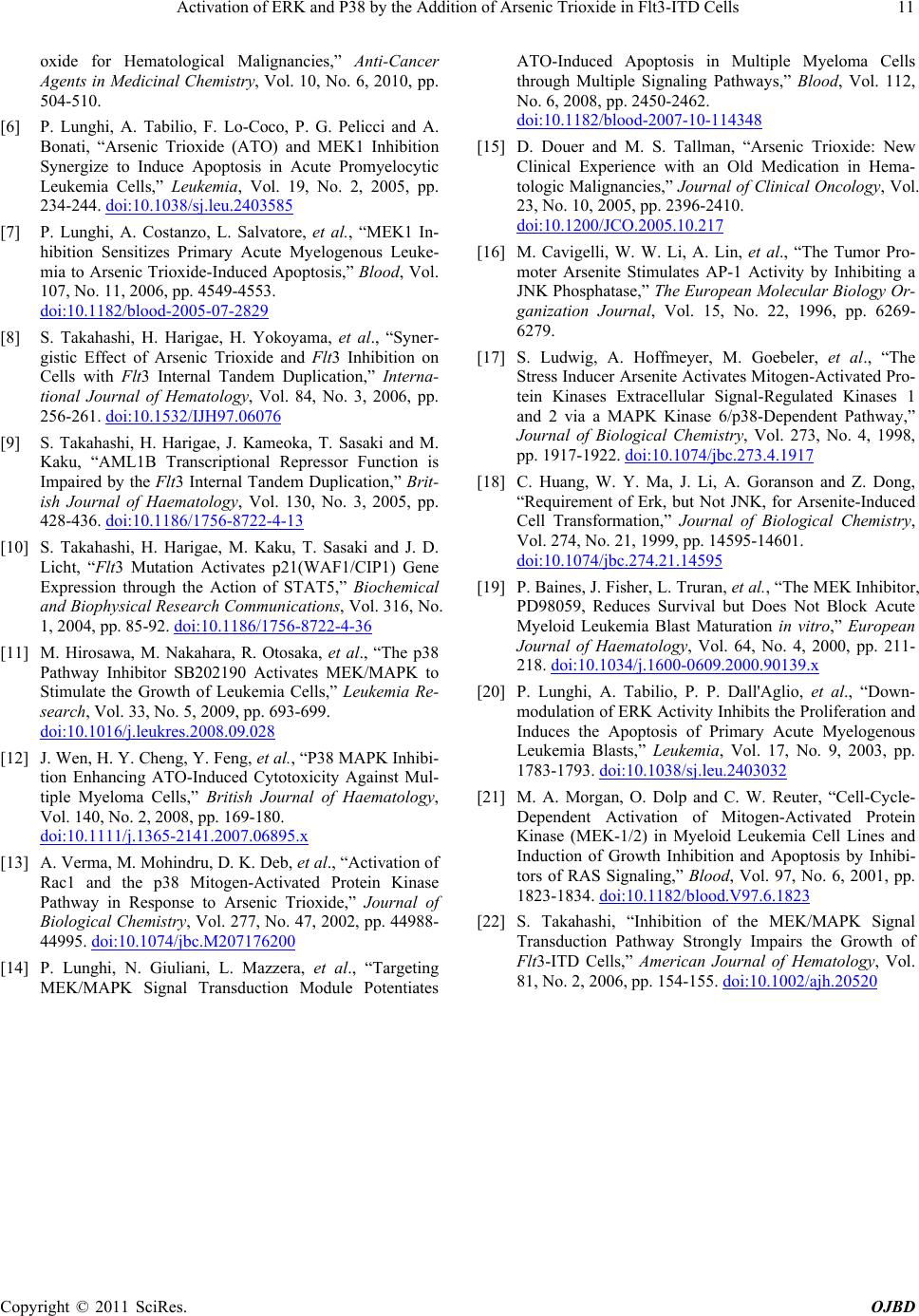
Activation of ERK and P38 by the Addition of Arsenic Trioxide in Flt3-ITD Cells
Copyright © 2011 SciRes. OJBD
11
oxide for Hematological Malignancies,” Anti-Cancer
Agents in Medicinal Chemistry, Vol. 10, No. 6, 2010, pp.
504-510.
[6] P. Lunghi, A. Tabilio, F. Lo-Coco, P. G. Pelicci and A.
Bonati, “Arsenic Trioxide (ATO) and MEK1 Inhibition
Synergize to Induce Apoptosis in Acute Promyelocytic
Leukemia Cells,” Leukemia, Vol. 19, No. 2, 2005, pp.
234-244. doi:10.1038/sj.leu.2403585
[7] P. Lunghi, A. Costanzo, L. Salvatore, et al., “MEK1 In-
hibition Sensitizes Primary Acute Myelogenous Leuke-
mia to Arsenic Trioxide-Induced Apoptosis,” Blood, Vol.
107, No. 11, 2006, pp. 4549-4553.
doi:10.1182/blood-2005-07-2829
[8] S. Takahashi, H. Harigae, H. Yokoyama, et al., “Syner-
gistic Effect of Arsenic Trioxide and Flt3 Inhibition on
Cells with Flt3 Internal Tandem Duplication,” Interna-
tional Journal of Hematology, Vol. 84, No. 3, 2006, pp.
256-261. doi:10.1532/IJH97.06076
[9] S. Takahashi, H. Harigae, J. Kameoka, T. Sasaki and M.
Kaku, “AML1B Transcriptional Repressor Function is
Impaired by the Flt3 Internal Tandem Duplication,” Brit-
ish Journal of Haematology, Vol. 130, No. 3, 2005, pp.
428-436. doi:10.1186/1756-8722-4-13
[10] S. Takahashi, H. Harigae, M. Kaku, T. Sasaki and J. D.
Licht, “Flt3 Mutation Activates p21(WAF1/CIP1) Gene
Expression through the Action of STAT5,” Biochemical
and Biophysical Research Communications, Vol. 316, No.
1, 2004, pp. 85-92. doi:10.1186/1756-8722-4-36
[11] M. Hirosawa, M. Nakahara, R. Otosaka, et al., “The p38
Pathway Inhibitor SB202190 Activates MEK/MAPK to
Stimulate the Growth of Leukemia Cells,” Leukemia Re-
search, Vol. 33, No. 5, 2009, pp. 693-699.
doi:10.1016/j.leukres.2008.09.028
[12] J. Wen, H. Y. Cheng, Y. Feng, et al., “P38 MAPK Inhibi-
tion Enhancing ATO-Induced Cytotoxicity Against Mul-
tiple Myeloma Cells,” British Journal of Haematology,
Vol. 140, No. 2, 2008, pp. 169-180.
doi:10.1111/j.1365-2141.2007.06895.x
[13] A. Verma, M. Mohindru, D. K. Deb, et al., “Activation of
Rac1 and the p38 Mitogen-Activated Protein Kinase
Pathway in Response to Arsenic Trioxide,” Journal of
Biological Chemistry, Vol. 277, No. 47, 2002, pp. 44988-
44995. doi:10.1074/jbc.M207176200
[14] P. Lunghi, N. Giuliani, L. Mazzera, et al., “Targeting
MEK/MAPK Signal Transduction Module Potentiates
ATO-Induced Apoptosis in Multiple Myeloma Cells
through Multiple Signaling Pathways,” Blood, Vol. 112,
No. 6, 2008, pp. 2450-2462.
doi:10.1182/blood-2007-10-114348
[15] D. Douer and M. S. Tallman, “Arsenic Trioxide: New
Clinical Experience with an Old Medication in Hema-
tologic Malignancies,” Journal of Clinical Oncology, Vol.
23, No. 10, 2005, pp. 2396-2410.
doi:10.1200/JCO.2005.10.217
[16] M. Cavigelli, W. W. Li, A. Lin, et al., “The Tumor Pro-
moter Arsenite Stimulates AP-1 Activity by Inhibiting a
JNK Phosphatase,” The European Molecular Biology Or-
ganization Journal, Vol. 15, No. 22, 1996, pp. 6269-
6279.
[17] S. Ludwig, A. Hoffmeyer, M. Goebeler, et al., “The
Stress Inducer Arsenite Activates Mitogen-Activated Pro-
tein Kinases Extracellular Signal-Regulated Kinases 1
and 2 via a MAPK Kinase 6/p38-Dependent Pathway,”
Journal of Biological Chemistry, Vol. 273, No. 4, 1998,
pp. 1917-1922. doi:10.1074/jbc.273.4.1917
[18] C. Huang, W. Y. Ma, J. Li, A. Goranson and Z. Dong,
“Requirement of Erk, but Not JNK, for Arsenite-Induced
Cell Transformation,” Journal of Biological Chemistry,
Vol. 274, No. 21, 1999, pp. 14595-14601.
doi:10.1074/jbc.274.21.14595
[19] P. Baines, J. Fisher, L. Truran, et al., “The MEK Inhibitor,
PD98059, Reduces Survival but Does Not Block Acute
Myeloid Leukemia Blast Maturation in vitro,” European
Journal of Haematology, Vol. 64, No. 4, 2000, pp. 211-
218. doi:10.1034/j.1600-0609.2000.90139.x
[20] P. Lunghi, A. Tabilio, P. P. Dall'Aglio, et al., “Down-
modulation of ERK Activity Inhibits the Proliferation and
Induces the Apoptosis of Primary Acute Myelogenous
Leukemia Blasts,” Leukemia, Vol. 17, No. 9, 2003, pp.
1783-1793. doi:10.1038/sj.leu.2403032
[21] M. A. Morgan, O. Dolp and C. W. Reuter, “Cell-Cycle-
Dependent Activation of Mitogen-Activated Protein
Kinase (MEK-1/2) in Myeloid Leukemia Cell Lines and
Induction of Growth Inhibition and Apoptosis by Inhibi-
tors of RAS Signaling,” Blood, Vol. 97, No. 6, 2001, pp.
1823-1834. doi:10.1182/blood.V97.6.1823
[22] S. Takahashi, “Inhibition of the MEK/MAPK Signal
Transduction Pathway Strongly Impairs the Growth of
Flt3-ITD Cells,” American Journal of Hematology, Vol.
81, No. 2, 2006, pp. 154-155. doi:10.1002/ajh.20520